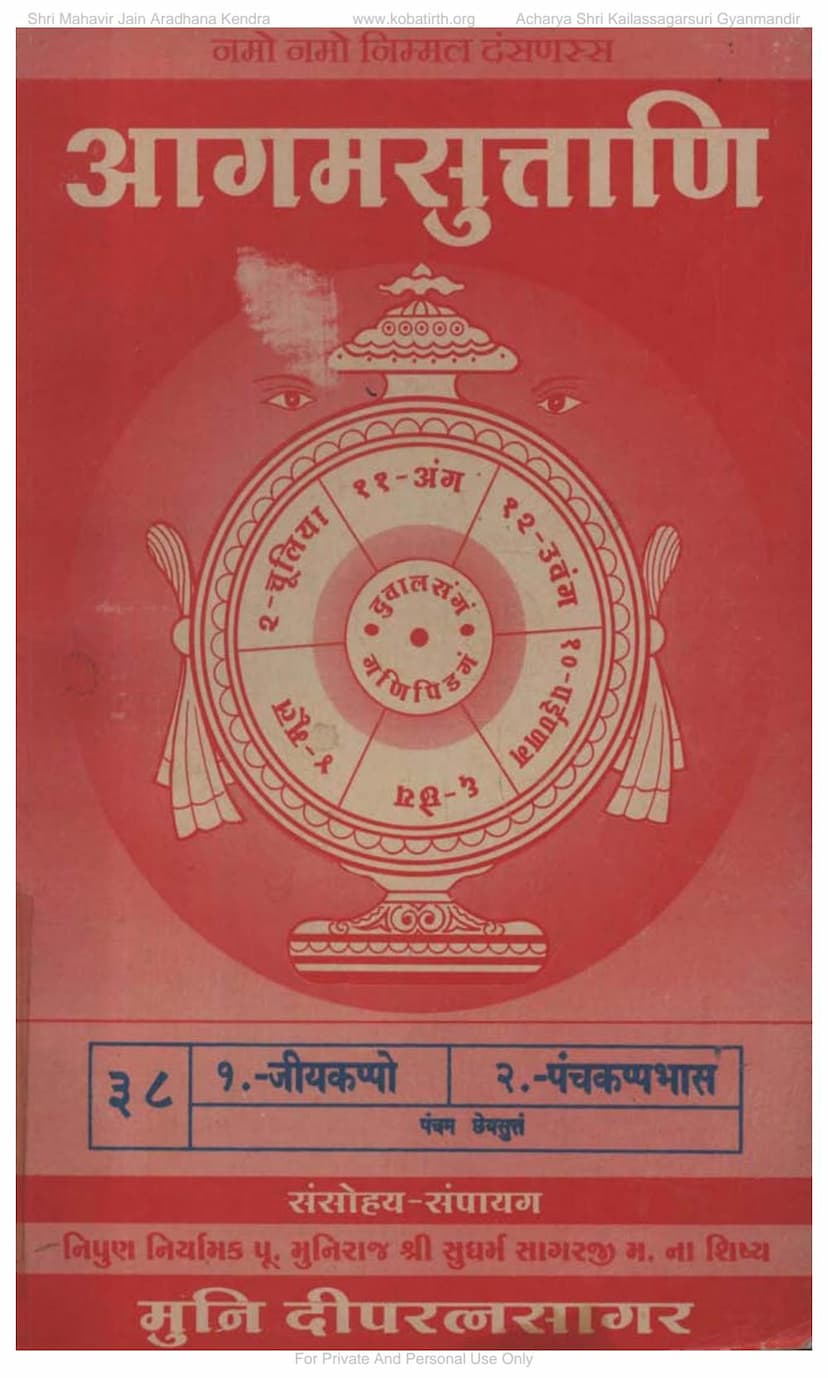Agam 38A Jiyakappo Chheysutt 05A Moolam
Added to library: September 1, 2025

Summary
This document appears to be the cover pages and preliminary content of a Jain religious text titled "Agam 38A Jiyakappo Chheysutt 05A Moolam." Here's a comprehensive summary based on the provided pages:
Overall Purpose and Content:
The document is a publication from "Agam Shrut Prakashan" and is associated with the "Shri Mahavir Jain Aradhana Kendra" and "Acharya Shri Kailassagarsuri Gyanmandir." It is part of a larger project to publish the Jain Agamas, specifically numbering 38A, with a focus on the "Jiyakappo Chheysutt" section, further identified as "Moolam" (meaning root or original). The text itself is presented in Gujarati and likely deals with the conduct and regulations for Jain ascetics (monks and nuns).
Key Information and Sections:
- Title: Agam 38A Jiyakappo Chheysutt 05A Moolam
- Author(s): Dipratnasagar, Deepratnasagar (likely the editors or translators)
- Publisher: Agam Shrut Prakashan
- Catalog Link: https://jainqq.org/explore/009766/1
- Primary Audience: Jain community, likely those interested in understanding or preserving Jain scriptures. The repeated phrase "For Private And Personal Use Only" indicates a restriction on commercial distribution.
Front Matter and Acknowledgements (Pages 1-5):
- Homage and Greetings: The initial pages include invocations and salutations to Jain Tirthankaras and revered spiritual guides (Acharyas and Munis).
- Identification of the Text: The document clearly identifies itself as part of the "Agam Sutrani" collection and specifically points to "Jiyakappo" as the fifth "Chheysutt" (likely a category of Jain scriptures).
- Financial Supporters: A significant portion of the early pages is dedicated to listing numerous individuals and Jain Sanghs (communities) who have provided financial support for the publication. This highlights a community-driven effort to bring these scriptures to light. The supporters are often mentioned in connection with specific spiritual inspiration (from Sadhvis) or in memory of individuals.
- Published Works List (Pages 6-8): Pages 6-8 provide a comprehensive list of other published works by "Abhinav Shrut Prakashan." This list includes a wide range of Jain religious and scholarly texts, such as:
- Grammar and linguistic works ("Abhinav Hem Laghuprakriya," "Krudantmala").
- Texts related to rituals and practices ("Chaityavandan Parvamala," "Vaiyaavach Sah").
- Panchangs (Jain calendars).
- Texts on ethical conduct for lay followers ("Abhinav Upadesh Prasad").
- Works on specific Jain practices like "Samadhimaran" (peaceful death) and "Tatvartha Sutra" (commentaries and analyses).
- A substantial list of the 45 Jain Agamas themselves, indicating a systematic effort to publish the entire corpus.
- Indexes and Future Publications (Page 9): Page 9 discusses the intended appendices and future publications related to the 45 Agamas. These include:
- "Vishayanukkramo" (Subject index).
- "Vishisht Shabdannukkramo" (Specialized word index, akin to a glossary).
- "Vishesh Namannukkramo" (Index of proper names).
- "Gathanukkramo" (Index of verses).
- "Sutrannukkramo" (Index of Sutras). This demonstrates a scholarly approach to making the Agamas accessible and navigable.
- Notes on Interpretation and Sources: The document includes notes on how to interpret the text, including the numbering system for verses and chapters, and the sources used for commentaries. It mentions specific commentaries and the scholars who edited them, as well as acknowledging the use of manuscript copies for certain sections.
The Text of Jiyakappo (Pages 10-17):
- Beginning of the Text: The actual text of "Jiyakappo" begins on page 10 and continues through page 17.
- Structure and Content: The text is presented in a Jain Prakrit language, with Gujarati annotations and numbering. The content appears to detail various aspects of ascetic conduct, including:
- Repentance and Confession (Alochan, Pratikraman): Several verses discuss the importance and methods of confessing and repenting for transgressions.
- Types of Penance (Tapa): The text seems to elaborate on different forms of ascetic practices and their application.
- Regulations for Ascetics: It likely covers rules related to food, shelter, movement, and interactions for monks and nuns.
- Consequences of Actions: The verses may also touch upon the karmic implications of adherence or non-adherence to these rules.
- Specific Categories of Rules: Phrases like "Chhed Sutra," "Mool Sutra," and "Painya Sutra" (found on page 7 and 8) indicate the categorization of Jain texts, and "Jiyakappo" is identified as a "Chhed Sutra."
- Verse Numbering: The text is presented with sequential verse numbers and often includes bracketed Gujarati numerals corresponding to the verses. English numerals are also present, likely referring to commentary references.
Concluding Remarks and Explanations (Pages 18-21):
- Explanation of "Chheysutt": Page 18 provides a discussion on the classification of Jain scriptures, particularly the six "Chheysuttas" (Śed-sutras). It notes that while 45 Agamas are recognized, only six are classified as Chheysuttas. It also mentions the original text of "Panchkappo" is not found, and "Niyaturyam" is considered in its place.
- Detailed Explanation of "Panchkappo" and its Companion Texts: Page 19 offers a detailed explanation of "Panchkappo," stating that its verses are mixed with those of "Vyaakhya" and "Laghubhashya." It explains the symbols used to denote these different sections.
- Notes on the "Laghubhashya": Page 20 provides specific notes regarding the "Laghubhashya" verses, indicating that their numbering is different and some verses might be missing or unnumbered in this edition.
- Final Acknowledgements: Page 21 includes a final acknowledgement and contact information for "Shri Mahavir Jain Aradhana Kendra" and the primary supporter, "Shrimati Naynaben Rameshchandra Shah."
In essence, this document is a significant part of a larger project to preserve and disseminate the Jain Agamas. It provides the specific text of "Jiyakappo Chheysutt," along with crucial context about its place within the Jain canon, its publication history, and the community efforts that made it possible.